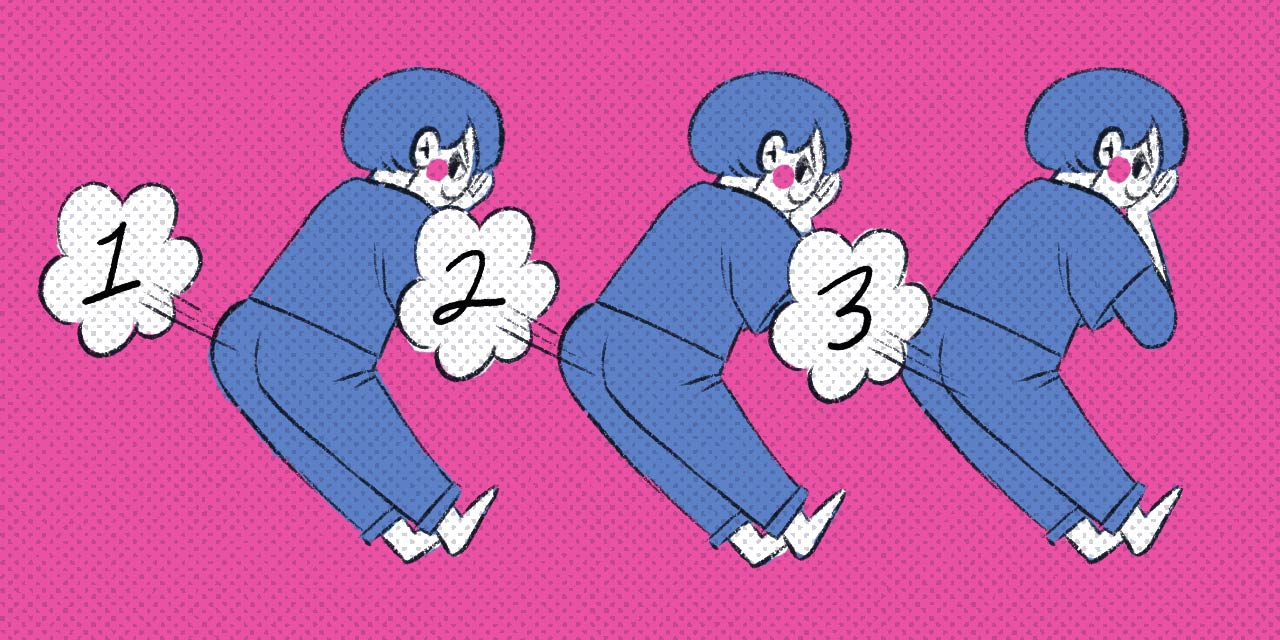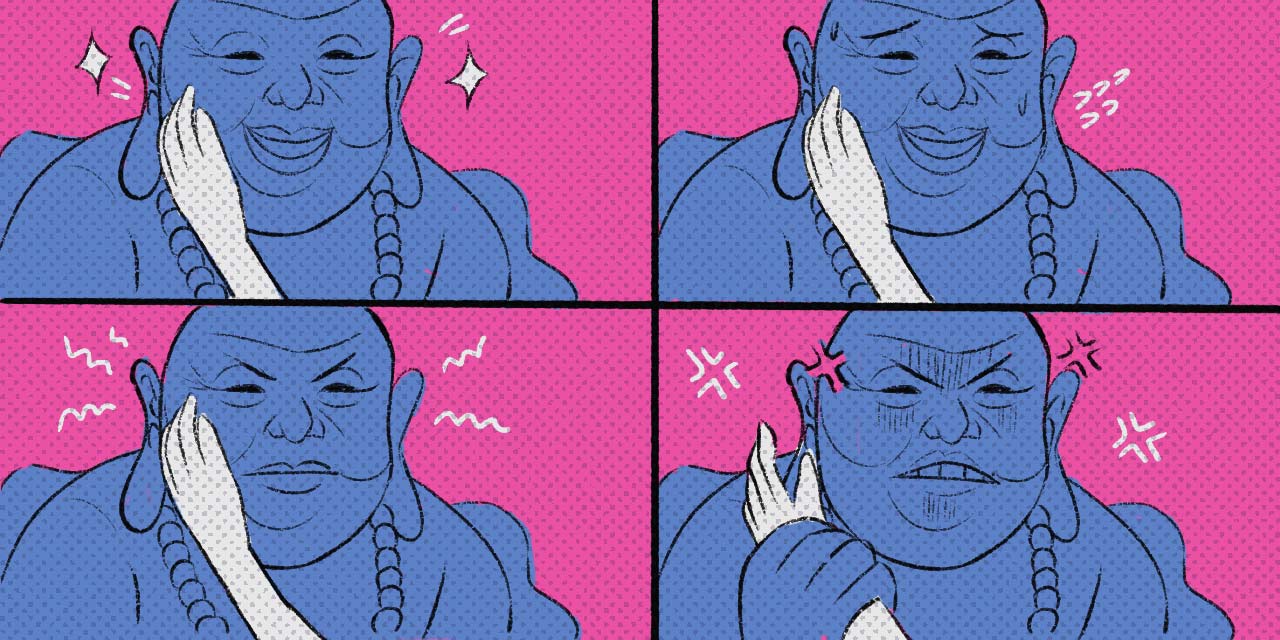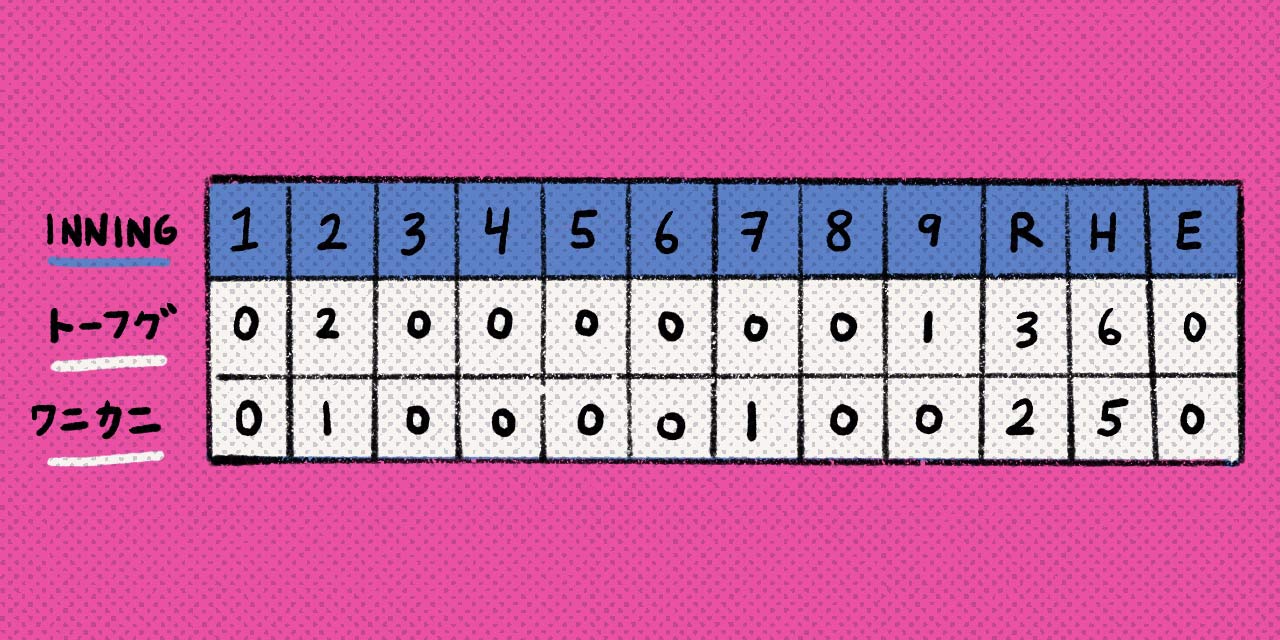If someone were to ask you, "How many times have you been to Japan?", you could answer, 「50回」—fifty times.
The Japanese counter 回 (かい/kai) counts frequency—i.e., the number of times something happens. For example, if someone were to ask you, "How many times have you been to Japan?", you could answer,「50回」—fifty times. That's the easiest way to think about 回: if you can count the number of times something repeats, or is expected to repeat, then 回 is the counter to use. If it's not likely to repeat, you'll probably want to use a different counter.
One way to help you identify 回 is by looking closely at the 口s (mouths). There's a 口 inside the other 口, making it 回. But if you look really closely, you'll see yet another 口 inside that middle 口. And another 口 inside that!
(Okay, that's actually not true. But it's still helpful, because now when you see 回, you can think, "How many times does the 口 show up?" A little mnemonic for you!)
- Pronunciation of Japanese Counter 回
- Repetitive Actions
- Regular Events or a Series of Events
- Divided Actions and Probability
- We Expect You to Read This Article Again
Pronunciation of Japanese Counter 回
Before we get into the nitty-gritty of 回, take a moment to study the table below to learn how to count each number. You'll find some shortened numbers in the list, so be sure to look closely.
| Numeral | Japanese | Reading 1 | |
|---|---|---|---|
| 1 | 一回 | いっかい | |
| 2 | 二回 | にかい | |
| 3 | 三回 | さんかい | |
| 4 | 四回 | よんかい | |
| 5 | 五回 | ごかい | |
| 6 | 六回 | ろっかい | |
| 7 | 七回 | ななかい (しちかい) | |
| 8 | 八回 | はちかい/はっかい | |
| 9 | 九回 | きゅうかい | |
| 10 | 十回 | じゅっかい/じっかい | |
| 11 | 十一回 | じゅういっかい | |
| 12 | 十二回 | じゅうにかい | |
| 100 | 百回 | ひゃっかい | |
| 1,000 | 千回 | せんかい | |
| 10,000 | 一万回 | いちまんかい | |
| How many | 何回 | なんかい |
For more about pronunciation, check out our Counting in Japanese Guide, as well as our Japanese Counters Guide, which will give you a big-picture explanation of the pronunciation changes that occur in numbers and counters.
But let's talk about 回. It's best to use this counter in cases where repetition is obvious: repetitive schedules, things that happen over and over again—things with distinct beginnings and ends that happen over and over again, and certain mathematical functions. We'll start by looking at general "repeating actions," then follow up with a few slightly different (but pretty similar) variations.
Repetitive Actions

Clear, repetitive actions are counted using 回. If you're jumping rope, for example, it's clear when the rope has made one full rotation. One rotation would be a 回, two rotations would be 2回, and so on.
- 縄跳びを10回跳んだ。
- I skipped rope ten times.
- スクワットを30回します。
- I'm going to do thirty squats.
- くしゃみが5回連続で出た。
- I sneezed five times in a row.
- コウイチがオナラを3回もした!
- Koichi farted three times!
- 一回オナラをした。
- I farted once.
While the sentences above are examples of actions that repeat more than one time, you can also use 回 to count an action that happens a single time. Wait, what? 🤔 How is this possible? If the action feels likely to happen again—like farts, burps, or sneezes, to name a few—you can count the first of a potentially repetitive set of actions with 1回.
- 一回オナラをした。
- I farted once.
Regular Events or a Series of Events

The second category of 回 is actually not so different from the first: events that repeat. Another way of putting it would be repeating actions within time.
- 毎朝腕立て伏せを20回する。
- Every morning, I do twenty push-ups.
- 毎日2回お風呂に入ります。
- I take a bath twice every day.
- 週1回剣道の練習がある。
- Once per week I have kendo practice.
- 年4回セールをします。
- We have a sale four times a year.
The events don't have to be close to each other. As long as they repeat, or as long as you expect they'll repeat, you can still use 回.
- 50回目の結婚記念日かぁ。
- It's our fiftieth wedding anniversary, right?
- もうすぐお婆ちゃんの三回忌だね。
- The second anniversary of Grandma's death is coming soon, huh?
Are You Sure It'll Repeat?

We've talked about using 回 for events we expect will repeat. What happens when we're not so sure? Or if we expect they won't repeat at all? In those cases, it's best to use the counter 度 (ど) instead. For example, if you've been to Japan once but think it's unlikely you'll go again, you might say:
- 日本には一度だけ行ったことがあります。
- I've been to Japan only once.
On the other hand, if you've been to Japan once and think you'll go again someday, you would use 回—even if you don't know exactly when you'll be going.
- 日本には一回だけ行ったことがあります。
- I've been to Japan only once.
This use of 回 is the same for repeating actions. When you don't expect an action to occur again, you would use 度 instead of 回, even if it's happened multiple times.
- 今まで2度優勝しました。
- We won the championship twice.
This example suggests you don't think it'll happen again. Yet maybe you're one of those crazed sports fans who believes your team is going to win every year. If you are, you can show that you expect and/or hope the action will repeat by using the counter 回.
- 今まで2回優勝しました。
- We won the championship twice.
While no one can predict the future, you can express your intentions, hopes, and dreams just by changing the Japanese counter you use.
It's the same when asking "How many times…?" If you ask someone, "How many times have you been to Japan?", you might use 回 to show you expect they'll go again, or 度 to indicate you don't expect them to. The following example sentences look the same, yet demonstrate the subtle feeling behind each counter.
- 日本には何度行ったことがありますか?
- How many times have you been to Japan?
- 日本には何回行ったことがありますか?
- How many times have you been to Japan?
- あなたの学校は何度優勝したことがありますか?
- How many times has your school won the championship?
- あなたの学校は何回優勝したことがありますか?
- How many times has your school won the championship?
Most Japanese people probably won't consciously process the difference between 回 and 度, and you're unlikely to offend someone by using the wrong counter. You definitely won't hear someone respond by saying, "What? You don't expect me to go to Japan again? How dare you!" For most speakers, recognizing this difference between 回 and 度 probably happens unconsciously—it depends on the person you asked.
And yet there are times when this difference is more overt. In the case of certain proverbs, for example:
- 仏の顔も3度まで
- Even with Buddha's, face you only get three times.
As Japanese evolves linguistically, we believe you'll see more and more mixing between 回 and 度.
The proverb refers (metaphorically, of course) to rubbing or stroking (撫でる) the Buddha's face. It warns that while you can get away with doing so three times, after that the Buddha will get upset and become annoyed with you. 回 isn't used in this case because (in theory, anyway) it won't happen a fourth time. In this case, we use 度 because there's a clear limit to the Buddha's metaphorical patience!
Another example when the difference between 回 and 度 is slightly more obvious is in situations where something is happening (or might happen) one-to-a-limited-number of times. If it's a one-time thing, or clearly limited, 度 is the correct Japanese counter to use. As in:
- チャンスは一度きりしかありませんよ。
- You only have one chance.
That said, Japanese speakers are beginning to use 回 and 度 more interchangeably, and the difference between the two is getting less and less significant. Even though they're not specifically referring to a repetitive action, many native Japanese speakers might say something like:
- 一回しかチャンスはありませんよ。
- You only got one chance.
As Japanese evolves linguistically, we believe you'll see more and more mixing between 回 and 度. Still, it's important to understand the difference between them. When it comes to communication, a lot depends on whom you're talking to.
Finally, even though it's becoming more archaic, there's a third counter: 編 (へん). Like 度, it emphasizes a single or limited number of repeating actions.
- 一遍言えば分かるよ!
- Saying it once is enough!
- 一遍にそんなに食べたの!?
- Did you eat that much at once!?
Divided Actions and Probability

We promise we won't discuss it too much, but 回 is used in mathematics as well. Say you have one action, then take that action and split it into two separate actions. The two actions can be counted using 回. For example:
- 一枚のパンケーキを二回に分けて食べた。
- I separated and ate a single pancake in two different servings.
Said another way, you couldn't eat a whole pancake, so you cut one in half, eating one part (1回) at one moment and the second (2回) at another.
Here's another example:
- 十二回払いでテレビを買った。
- I bought a TV in twelve installments.
One payment was divided into twelve parts—each installment is 1回. How would you count your 10th installment? 10回, of course.
This use of 回 applies to other real-life categories, including for the units that certain sports and games are separated into: baseball innings, boxing rounds, hockey periods—even successive games of rock-paper-scissors. They're all counted with 回, even though you would expect a baseball game (for example) to end after nine innings. You use 回 because you're dividing something bigger into separate pieces.
- 3回裏に3点を入れられた。
- In the bottom half of the third inning, three runs were scored on us.
- 2回戦でK.O.負けした。
- I was KO-ed in the second round.
- トーナメントの4回戦に進むことになりました。
- We're going to move on to the fourth round of the tournament.
- ジャンケン、3回勝負にしよう。
- Let's do a three-game rock-paper-scissors match!
One note—some foreign sports get special gairaigo counters. Baseball is a good example: innings can be called イニング or 回, though in Japan, 回 is still most common.
Lastly, another way to use 回 is when expressing probability.
- 5回中1回だけ成功した。
- I succeeded in only one out of five tries.
In this case, the speaker is taking 5回 and dividing it into separate pieces, each one also counted using 回. Here are two more examples:
- 5回中2回だけ成功した。
- I succeeded only two out of five tries.
- 5回中5回成功した。
- I succeeded five out of five tries!
We Expect You to Read This Article Again
How many times have you read this article? 1回? 2回? 1度? Wait, you don't expect to read it again?! 😉 Actually, we didn't notice the subtle difference, and neither will a lot of people. Don't worry about it too much. The 回s and 度s of the Japanese language are converging, so it's all good.
When you're ready for more counting, check out some of the other "deep dive" Japanese counters articles we've written: 階, 頭, and 羽 are good ones.
And if you're new to the world of counters, we recommend you learn the basics of Japanese counters, and then scroll through our massive counters study list, which can take you to all the counters we've written about in-depth.
-
Cells with multiple entries divided by a
/indicate multiple pronunciations that are equally common. Cells with entries in parentheses indicate that the parenthesized word is an uncommon or archaic pronunciation. ↩
